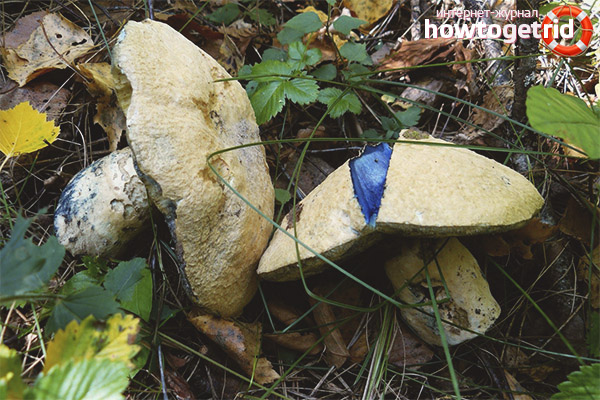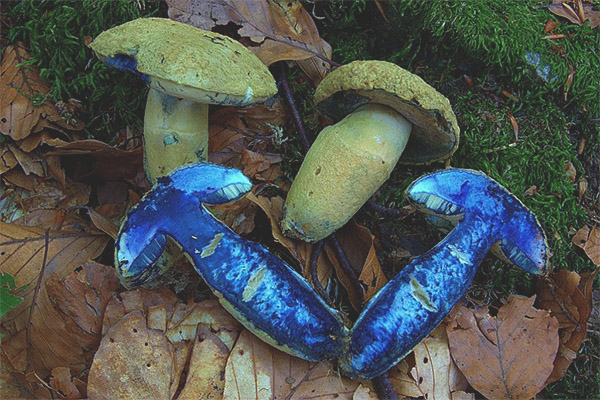The content of the article
One of the edible, and at the same time quite rare, and therefore not recommended for eating types of mushrooms, is a blue-growing gyroporus, also popularly known as a “bruise”, so named for its very specific color response to a cut that turns blue some time after collection. Despite the fact that this representative of the kingdom of mushrooms can be eaten without doubt, it is not advisable to do this, since at present it is one of the endangered species listed in several regional Red Books of our country.
For many beginners or not-too-experienced mushroom pickers, a bruise accidentally discovered in the forest can be an unexpected find, which may well be located in the midst of white mushrooms or boletus common to each of us. Most likely, many of those who are not familiar with this forest dweller will simply pass by, considering it not particularly edible.Or thrown out, taking for poisonous because of the specific blue in the cut, which sometimes can surprise even experienced lovers of quiet hunting. Nevertheless, the blue-growing gyroporus is one of the traditional representatives of the nature of our band, and therefore deserves more careful attention.
Description
The bruise of the fungus (in scientific Latin, having the name Gyroporus cyanescens), also known under the names of the blue-growing gyroporus or birch gyroporus, refers to tubular fungi of the gyroporus (gyroporic) family of the Boletovy class Agaricomycetes. His names, both popular and official, he received for the rare property of its pulp. For example, in a stem or cap, it is quickly able to change its original white color to a bright and saturated blue. And in any place of damage, be it a knife cutter of a mushroom picker, pressured fingerprints or, for example, an animal bite.
The shape of the bruise cap varies with its age - in young mushrooms it has a convex shape, but as it grows, it gradually becomes flattened. The skin of the fungus has a pleasant matte appearance with a yellowish-brown or whitish-cream color, with the slightest damage is covered with bright blue spots.To the touch, the surface of the gyroporous blue cap is dry and has a velvety felt texture. Its average diameter is 5-8 centimeters, although there are often specimens with a cap width of 15 centimeters.
The flesh of a bruise fungus has a white or tender cream color, it breaks easily, acquiring a cornflower shade at the place of a break or cut. The taste is nutty, there is practically no characteristic smell. The tubular layer of the fungus, with a thickness of up to 10 millimeters, with small pores, also has a white or cream shade, immediately turning blue when it is damaged. Spore powder has a pale yellowish color.
The smooth leg of the gyropopus is turning blue, devoid of a ring, reaches a thickness of up to 3 centimeters, and a height of 5 to 10 centimeters. At the base it is thickened, and under the cap has a pointed shape. Color, as a rule, either white or copying the color of the cap, sharply giving into the blue after touching. The structure of the leg of a young mushroom is dense, and in an adult it is hollow. A bruise is considered an edible mushroom belonging to the second food category, with a taste that does not taste bitter and has a fairly good nutritional value, for example, compared to other members of its family, such as gyroporus chestnut.
Distribution and collection

Gyroporus is blue, it is a bruise, every year it occurs less and less. In some regions, it is officially listed in the Red Book. In the country, the mushroom grows in deciduous and mixed forests, in the temperate zone, in areas with a humid climate, on birch roots, chestnuts and oaks. One of the most common habitats - sandy soils. Mushroom picking can begin as early as mid-summer, and it lasts until mid-autumn - until October.
Similar species
Eating
Mushroom bruise has a pleasant nutty taste and a barely perceptible mushroom flavor, can be eaten both in boiled and fried form, as well as in the form of blanks for the winter - dried or pickled. The caviar and various sauces made from the blue giroporus are distinguished by their excellent taste. However, not everyone can enjoy the dishes prepared from it - in some regions of the country a bruise is listed in the Red Book. The fact is that it bears fruit very poorly and spreads, and therefore it is extremely rare. Therefore, to cut such mushrooms is not recommended.
Video: Bruise (Gyroporus cyanescens)











To send